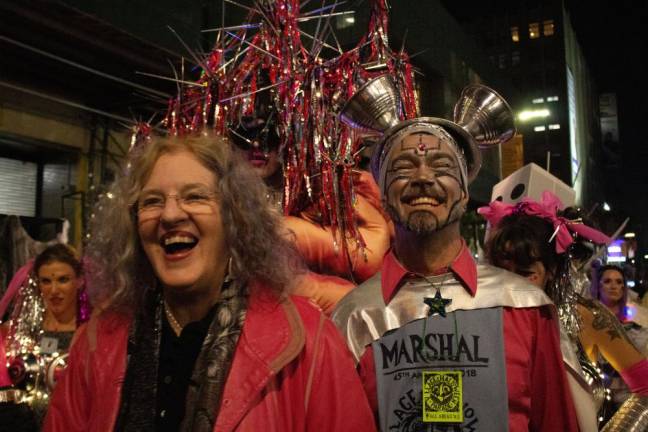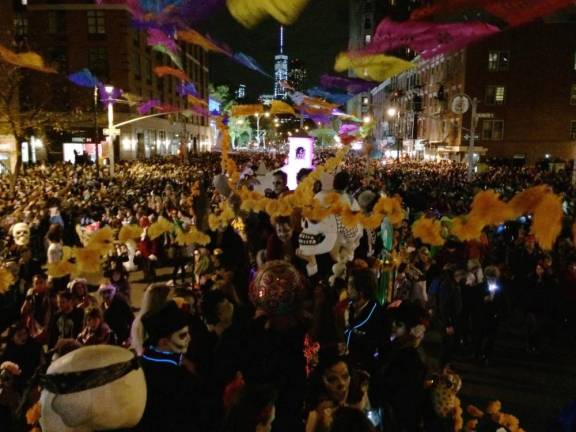Her ‘Magical Thinking’ Brightens Halloween in New York
Jeanne Fleming, the organizer of the annual Village Halloween Parade, now in its 48th year, takes us behind the scenes of the world-famous celebration


For Jeanne Fleming, every day is Halloween. As the artistic and producing director of the Village Halloween Parade, she said she literally works on the event year-round and refers to her job as putting the “magical thinking” behind the iconic extravaganza, which has a staggering over-1 million viewers at home and “a couple million” who show up on the night of October 31st.
On a typical day, hopeful revelers call and send emails — they come in at a rate of over 100 an hour in the general parade inbox, which Fleming herself responds to — asking for advice on everything from costume choices to the best place to watch from to where to have dinner. “And I answer every single email,” she said. “That’s part of the magical thinking.”
As for her initial involvement, Fleming, who is in her 40th year at the helm, was involved in large-scale outdoor theater projects when she took over for Ralph Lee, a mask maker and puppeteer, who founded it in 1974. With her deep-rooted history as the leader of all the festivities, her memories of the parade include it being the first event to happen in the city after September 11 and having to cancel it after Hurricane Sandy.
A native of Philadelphia and the daughter of a funeral director, Fleming hosted Halloween parties every year, decorating with the caskets her father had in the makeshift showroom in their basement. And as soon as she procured a car, she would come to New York to visit, ultimately relocating here at 19 when her husband got a job as a professor at Bard College.
Fleming, who is constantly hearing heartwarming stories of what the parade means to individuals not just in this city, but around the country, is always taken aback by the depth of their responses, especially when they tell her that they figured out their identities through their participation. “I really deeply believe that when people get to have that experience of creation and making, it changes your heart; it changes your soul,” she said. “And I think it makes the world a better place.”
I saw a video interview with you where you said 2020 was slated to be the “greatest parade maybe ever,” and then it got canceled.
Well, the Halloween parade was going to be on a Saturday night with a full moon — and that shapes out to be a kind of wonderful night for the parade because people don’t have to worry about getting up the next day; there’s a larger attendance, usually. We also have more sponsorship, which means that we raise enough money actually to help us through a couple of years of trying to raise money for the parade. So, everything about it was just poised to be marvelous and wonderful and of course, it was canceled.
Let’s talk about how much planning goes into this. I saw another interview where you said that not a day goes by where you aren’t doing something for it. So is it truly a year-round thing for you?
Yes, it’s a year-round thing. That’s really true. I mean it’s one thing or another, always, that comes up — whether it’s people writing scholarly articles about the parade or inquiries of all different kinds. You know, the event now is a world-famous event, and so people are constantly contacting me in all different kinds of ways. After the parade, a lot of people are looking for photographs of themselves, and they want to tell me their stories. But of course, the minute it’s over, I’m beginning to work on the next one. I have to do all the accounting; I have to start to raise all the money, which is something I usually spend a year doing. So, yeah, there’s hardly a day, whether it’s a puppet has fallen over in the barn that needs to be picked up, it could be anything, but Halloween is definitely something that is part of every day.
So you did get a donation this year, which I saw on your website.
Yes, astonishingly. Well, because of last year, of course, like everybody, we lost a ton of money. And this year, we were told by the city quite late that we could do the parade, so I had to do a year’s work in six weeks, essentially. Some people were opting out of events this year, so normal sources of income weren’t there. So we decided to do like a Kickstarter, though it was through another type of funding for nonprofits.
But we knew it was gonna be hard to raise the money, because we had done it before, after Hurricane Sandy. That was another year when the parade was canceled. And we tried to raise the money then, and we learned a lot. The parade is something that they call “for the public good;” it’s free, and so people think it’s somehow put on by the city or “Oh, it will happen anyway,” or “Why should I pay when the person standing next to me didn’t.” And so we learned after Sandy ... most of the money came from four individuals. Right now, if you look on our page, you’ll see 180 people gave $12,000.
Then, one day, this man, Jason Feldman, called me on the phone and said, “I want to make a substantial donation.” And he said, “I love the parade. I’ve been in it since I was 14 years old; I’m 64 now. I grew up in the Village; my dad worked for the city.” He saw people jumping out of the Towers and that made a huge difference for him, his father also saw that. And when he heard about it [the parade fundraiser], he was just moved to do something for his city and he felt this was something that he could do that would be very good for the spirit of the city. And he asked me how much money I needed to meet the minimum budget, and he gave me that much money. That was on September 26 or something, and we were going to cancel the parade on October 5.
How many people show up each year and how do you tally that?
Well, it has to do with estimates the police make and also estimates that we can see. We know what the television audience is, which is over a million. We know that a couple million people show up to see the event. I know about 20,000 of the people who will be in the parade; I plan that part. But then another around 50 to 60,000 people show up to be in it in their own costumes. A lot of other parades, what happens is, they line up on all these streets, they move out slowly and you wait for hours, you don’t know when you’re going to go out. That’s not the case with this one. It’s called like a stage show, so what we do is we send out a float — 2,000 people, a band — 2,000 people, so we can tell, during the course of the time — between 7:00 when it starts, and 9:30 or 10, when the last group goes out. We are sending people out at the rate of 2,000 every 10 minutes or so.
No wonder it’s a lot of work!
Yes, it is! Well, I have brilliant, brilliant people working with me. Most people who’ve worked on the parade have been working on it 30 years. Once people start on it, they don’t leave until there’s a really good reason to — one person got sick, another person fell in love with someone from Australia and moved away, but most of the people are New Yorkers and they love the city and they love the Halloween parade. And they’re all amazing professionals. For example, one of my marshals, who just handles one small aspect of the parade, ran WorldPride. A lot of the staff at the end of the parade are from CenterStage, they work Central Park, they run the family reunion at the Marathon, all the big events. They’re all extraordinary people.
How do you keep the environment so safe?
Well, we plan it pretty carefully. It’s what’s called a feast crowd, a happy crowd. There’s a book called “Crowds and Power,” and in there, they describe what the Halloween parade is. Also there’s a new term that I just learned from this man Adam Grant, he’s writing for the “New York Times,” and he wrote a piece on lethargy, about how people are feeling during COVID. And in it, he describes a cultural phenomenon, which is when people get together in a large group and do something together, it produces a sense of, what he calls, collective effervescence. And that is a feeling you don’t get in any other way.
I mean I knock on wood, of course and I worry of course, always, but we work very closely with the NYPD. You cannot do this without them; they are extraordinary and have been huge supporters of the event. So we have them as copartners.
And this year, I really feel this is a gathering of the tribes because we don’t have sponsors this year to speak of. A lot of times, in events, people have to be there because their club is participating or their business, you know? On Halloween night, everyone who’s there is there because they want to be there and they’ve made an effort to live in their fantasies, to create something. After 9/11, they were interviewing people, and kept asking them, “Why did you show up? It was a terrorist attack.” And they were like, “Because these are my people. This is the night when I can be in my city and I can be out and be free and dance. This is my community.” And that amazed me, that they said things like that.
Tell us a memorable story that has stood out over the years.
This woman came up to me and said, “My brother is in the Halloween parade.” And I was like, “That’s great.” And she said, “No, you don’t understand, my brother was in the war in Vietnam, and he was disfigured by napalm, and his job is working in a tower in a forest. He never sees any people because he’s so horrifying-looking. On Halloween night, he comes up from his tower in Pennsylvania, and he is in the parade without a mask and all the beautiful girls will dance with him. And people treat him like he’s normal. It’s the only night of the year that he feels normal.”
This interview has been edited and condensed.
For more information, visit www.halloween-nyc.com